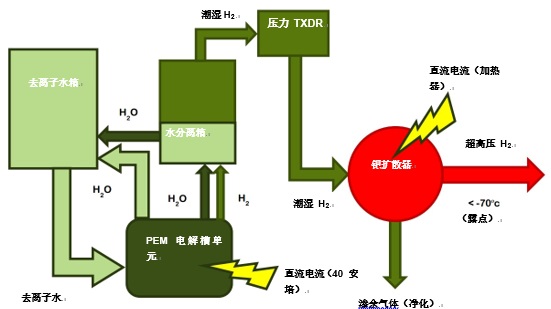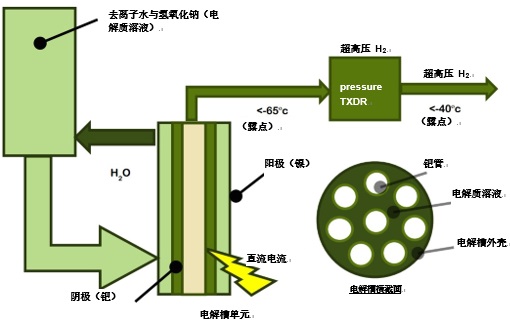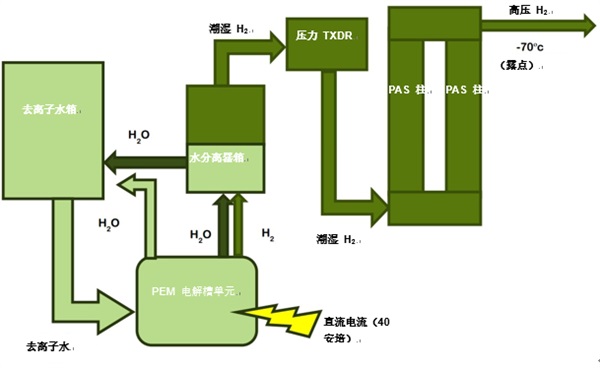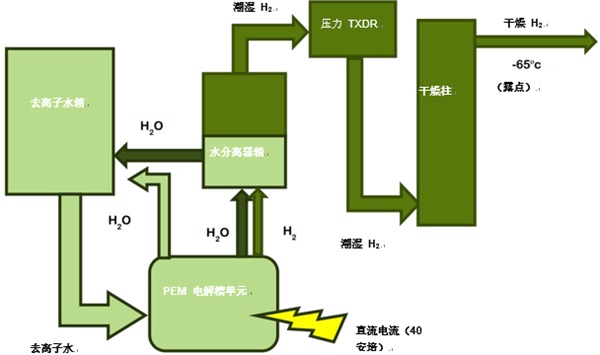Study on purification method of hydrogen
Technical considerations on hydrogen generation technology
Hydrogen generators that provide carrier gas for gas chromatography and gas chromatography/mass spectrometry applications utilize a variety of techniques to provide high purity hydrogen. This article will explore various hydrogen purification methods. The first three methods use a combination of PEM (proton exchange membrane) and various purification techniques, and the fourth method uses a comprehensive palladium electrolysis cell.
PEM/palladium diffusion
The palladium thin film hydrogen purifier works with a pressure driven cross-palladium film diffusion principle. Only hydrogen can diffuse through the palladium diffuser. Palladium diffusers come in a variety of styles, including tubes, spiral tubes or film foil arrays. The palladium diffuser is made of a palladium-silver alloy material that has a unique property of allowing only a single atom of hydrogen to pass through its crystal lattice when heated above nominally 300oC. The hydrogen molecules in contact with the surface of the palladium film dissociate into monoatomic hydrogen and pass through the film. On the other side of the palladium membrane, the monoatomic hydrogen is recombined into diatomic hydrogen.
PEM/palladium diffusion process

Features and advantages
• Ultra high purity hydrogen with little moisture or oxygen to carry. The purity is over 99.99999%.
• No routine maintenance required.
• The expected normal life of the palladium diffuser in the purifier is approximately 5 years, depending on the application and usage (source: http://pureguard.net/cm/Library/FAQs.html)
problem
• When palladium-silver alloy is used, accidental power failure can cause irreversible damage to the diffuser.
• Palladium-silver alloys absorb hydrogen, causing an increase in volume or a tendency to become brittle.
• If the diffuser breaks due to a hole, there is no economic advantage to repair it.
• Keeping the palladium film uncooled in the presence of hydrogen is critical to extending service life. Even if the purifier is operated outside the optimal operating temperature range for a short period of time, it will reduce its durability.
• After the hydrogen enters the “purification†side of the diffuser, it is necessary to periodically clean the remaining hydrogen on the “unpurified†side of the cell (still containing impurities such as oxygen and moisture). This ensures that a sufficient amount of hydrogen molecules can be transported across the palladium membrane to maintain diffuser efficiency. This process is very complicated, and if the system is not well designed, it will cause a pulse effect on the diffuser output pressure/flow.
• The reaction takes place at very high temperatures, and any source of ignition in the process is very dangerous, which can cause safety concerns. The current used to drive the heater box is very dangerous at this temperature and can cause significant arcing if any problems occur.
• The palladium film in the purifier needs to be replaced and the replacement interval is approximately 5 years.
• It is recommended to use a spare cell to eliminate downtime.
• Carbon emissions are greater because electricity needs to be used to heat the palladium alloy to operating temperature.
Palladium cell/purifier integrated system
With a metal palladium anode, since water cannot effectively conduct current, a strong water-soluble electrolyte is added, and usually 20% sodium hydroxide (NaOH) is used. The palladium tube bundle acts as a cathode, and only hydrogen and its isotopes can pass through the cathode to produce ultra-high purity hydrogen.
Palladium cell/purifier integrated system

Features and advantages
- Ultra-high purity hydrogen, almost free of moisture and oxygen
Problem • The electrolyte solution in the cell must be replaced every 12 months. The electrolyte used is NaOH (sodium hydroxide), which is a corrosive substance and must be handled with care. The replacement process requires at least 8 hours of cooling time and 4 hours of start-up time. All previously used electrolyte solutions must be drained beforehand.
• Sulfur-containing compounds and unsaturated hydrocarbons reduce permeability.
• Sodium hydroxide can corrode equipment and cause damage over time.
• Use of poor quality electrolytes can damage the electrochemical cells of the cell.
• There is a risk of electrolyte leakage that can burn the skin.
PEM/adsorbent pressure swing adsorption
The pressure swing adsorption technique works by changing the flow through two columns of adsorbent (bead) columns, with the adsorbent material acting as a molecular sieve. When hydrogen passes through one column, a small amount of dry gas is passed along the other column. When there is no adsorption capacity, the adsorbent material will be forced to regenerate. This action completely regenerates the adsorbent material in the column, so there is no need to change the material. After a small amount of product hydrogen has washed away the waste, the container is ready for the next production cycle. The hydrogen produced is extremely dry and has a moisture content of only 1 ppm.
PEM/adsorption PSA process

Features and Benefits • High stability and renewable technology.
• No high voltage or high current associated with it.
• Continuous hydrogen flow with no pressure fluctuations or pulse effects.
• Maintenance requirements are limited to the replacement of the deionizer box. No need to change desiccant or dangerous corrosives.
• Startup and shutdown procedures are short and easy.
• Easy to operate and reliable.
• Lower energy consumption compared to other hydrogen purification methods, resulting in lower operating costs.
• Industry studies have shown that palladium technology can produce the driest hydrogen, but according to Agilent Technologies' purity recommendations, PSA is sufficient for gas chromatography/mass spectrometry requirements.
problem
- Electrolytic cell replacement costs are higher.
- Hydrogen used to regenerate molecular sieves is vented to the air. It is also possible to select a hydrogen generator in the market that passes this portion of hydrogen through the catalyst to eliminate the discharge of hydrogen to the air.
PEM/silica drying system
The use of silica gel drying columns is another common purification method and is widely used because of its simplicity. Hydrogen produced using PEM technology flows through a stainless steel drying box to remove moisture. The drying column usually consists of silica gel beads, which act as a desiccant in hydrogen to produce high purity hydrogen that meets industry purity requirements.
PEM / silica gel drying process
Features and advantages
- Dryer
 Silicone) and the deionizer box are easy to replace.
Silicone) and the deionizer box are easy to replace. - Meet the general requirements of gas chromatographic purity.
- Compared with other purification methods, it is cost-effective.
problem
- There will usually be some moisture or oxygen carried.
- The desiccant (silica gel) requires continuous monitoring and periodic replacement, depending on system usage. When used frequently, the drying box may need to be replaced weekly.

Ed Connor DR.SC. is an expert in GC-MS applications. He joined Peak last February and received his Ph.D. from the Federal Institute of Technology in Zurich, Switzerland. He then joined the University of Zurich, where his work focused on the collection and analysis of volatiles using gas chromatography and GC-FID +44 141 812 8100,
Glass Venlo Greenhouse is Spire-type glass design, design and installation of windows when more convenient and easy. Its roof slope andle can be appropriately according to the local real climate change the environment.
In Venlo greenhouse, foundation is made of reinforced concrete and the side wall is made of brick or reinforced concrete plate. the steel frame always use hot dip galvanized light steel. Roof beam adopts horizontal girder structure and using herringbone connection. The horizontal girder bears 2 or more roofs, which is made of aluminum alloy. This material is used as roof structure material and also glass inlay material. Other beams using gutter style to minimize the section. Delighting material of the roof and side wall using 4 mm thick float glass.
Glass Venlo Greenhouse,Flowers Glass Greenhouse,Nursery Glass Greenhouse,Vegetables Glass Greenhouse
JIANGSU SKYPLAN GREENHOUSE TECHNOLOGY CO.,LTD , https://www.greenhousehydroponic.com